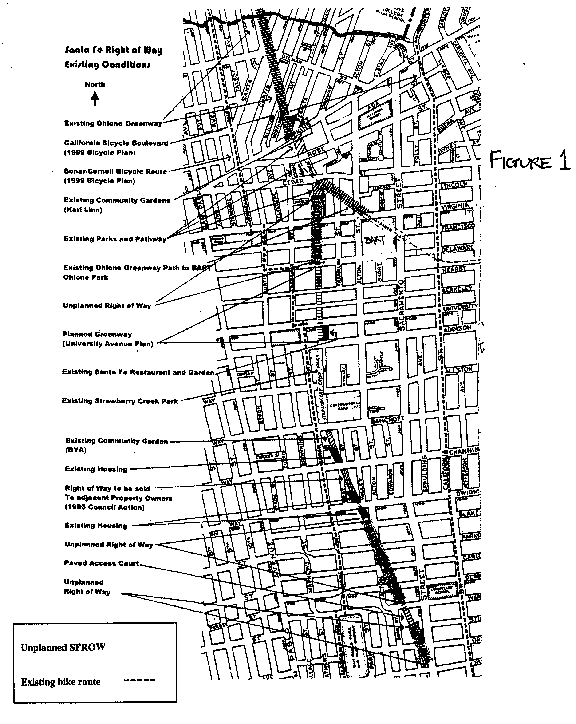
SANTA FE RIGHT-OF-WAY:
CONCEPTS ALONG THE WAY
City Planning 116 Studio
Professor Stephen Wheeler
University of California at
Berkeley
Spring 2003
|
ECOLOGICAL RESTORATION: |
UNIFYING THE RIGHT-OF-WAY: |
|
Joydip
Basu |
Brinda
Mehta |
|
Saana
Deichsel |
Baljeet
Purewal |
|
Harland
Patajo |
Ryan
Rominger |
|
Guadalupe
Bumatay |
|
|
|
|
|
CONNECTIONS: |
COMMUNITY REVITALIZATION: |
|
S.
Brian Huey |
Daniel
Choi |
|
Meaghan
Kay |
Amanda
Levy |
|
Sheila
Paigly |
Rudy
Almeida |
|
Jenine
Schmidt |
Sandy
Thomas |
|
|
Cynthia
McCormick |
TABLE OF CONTENTS
Connections: Past, Present and Future
Ecological Restoration on the Santa Fe Right-of-Way
Final Conclusions and Recommendations
CONTACT
INFORMATION:
Professor
Stephen Wheeler
College of Environmental Design
Department of City and Regional Planning
228 Wurster Hall
Berkeley, CA 94704
Phone: (510) 642-3256
This final concept report was assembled by class members of the Undergraduate Planning Studio at the University of California at Berkeley during the Spring of 2003.
This report is the culmination of a semester-long analysis of the Santa Fe Right-of-Way where we went from having little or no idea about the history of the Right-of-Way, to creating a detailed concept plan of the best uses we see fit for the Right-of-Way. Over the course of the semester, we were able to have lengthy discussions with neighbors and educational presentations from city advocacy groups, to get a better idea as to how the Right-of-Way can best-serve the local residents and City of Berkeley.
The results of our initial analysis report led
us to further develop four main concepts or themes that we see as potential
designs for the future of the Santa Fe Right-of-Way: Ecological Restoration;
Connections: Past, Present, Future; Unifying the Right-of-Way; and Community
Revitalization.
While
these themes may not be realized in their entirety, we hope that aspects of each
report will fuel discussion and enthusiasm within the community and the city as
they represent the incredible breadth of possibilities and potential diversity
for development on this site.
We are aware that some of our project designs may not fit into the overall budget for this project but we feel it is our responsibility to design beyond the limits of common discourse.
Please refer to Figure 1 for an orientation of the Right-of-Way within the city.

“Providing citizens with physical, social and historical means of connection to the Santa Fe Right-of-Way”
GROUP
MEMBERS:
Meaghan Kay
S. Brian Huey
Jenine Schmidt
Sheila Paigly
In the early 1900’s the Santa Fe Right-of-Way was seen as an integral connection allowing the transportation of passengers and cargo from Berkeley to other cities in the Bay Area. The Right-of-Way was seen as a standard mode of transportation within Berkeley, and prior to the popularization of the automobile in the 1930’s, it was probably looked upon as one of the most convenient ways to getting to and from cities along its tracks.
Today, we are presented with a somewhat different
picture. Automobiles are becoming increasingly less convenient in many Berkeley
citizen’s eyes; they have experienced the difficulty getting to and from
different parts of the city yet alone to and from other cities in the Bay Area.
As a solution, many are opting to walk, ride bicycles and use public
transportation as an alternative to driving cars. Given this failure of the
automobile to meet many citizen’s transportation needs both in terms of the
environment and efficiency, the Santa Fe Right-of-Way once again presents the
potential for providing a much needed connection for the city of Berkeley.
Connections: Past, Present and Future envisions the Santa Fe Right-of-Way connecting citizens, not only physically through transportation, but socially and historically. The re-use on the Right-of-Way will serve to foster all of these different connections through its physical relation to neighborhoods and community areas. People will be able to connect to Berkeley’s past by learning about the historical role the Right-of-Way played. They will better connect to the present by being able to get around via an improved bicycle boulevard network where the Right-of-Way plays an important role in connecting Berkeley to the neighboring cities of Albany and Emeryville. The Right-of-Way can also be seen as a connection, or the connection to the future, for it will also play a role in connecting Berkeley to the larger Bay Trails network, as well as fostering economic vitality through commercial development.
Using Census Bureau data, it was found that neighborhoods
along the Right-of-Way used bicycles as a mode of transportation less often than
the average Berkeley citizen despite having seven separate bicycle boulevards
within the vicinity of the Right-of-Way. It is not the case that opportunities
for using bicycles as a major mode of transportation don’t exist. Instead we
must shift our focus towards the quality of the boulevards —
how they relate to other structures, how accessible they are, and how
they increase accessibility.
While there are many bicycle friendly streets and paths in Berkeley, they exist within a city fabric than can often times become difficult — even dangerous to navigate on a bicycle. For example, the Bonar/Chestnut bicycle path can often require a considerable amount of maneuvering in order to cross the four crowded lanes of University Avenue during peak traffic hours. By placing a bicycle/pedestrian greenway on the northern portion of the Right-of-Way from Addison St. on and by removing that portion of the Bonar/Chestnut bicycle path that runs parallel to it, Berkeley’s bicycle network becomes more conjoined and increases safety as well as accessibility.
Developing a greenway on the northern portion of the
Right-of-Way improves both inter-city and intra-city connections. University
Avenue represents a significant physical boundary that separates North and South
Berkeley; the design of the crossing at University Avenue is meant to reflect
the conjunction of these two communities. Please refer to Figure 2 for
a detail of the proposed University Avenue crossing. The reconnection hopes to
expand on the use of both Strawberry Creek Park as well as Cedar-Rose Park, both
of which currently suffer from the boundary of University Avenue. In addition,
the University Avenue Connection will also serve as a hub for other bicycle
boulevards, connecting Berkeley to the Marina and the Bay Trail via the
bicycle/pedestrian bridge over 1-80 as well as connecting people to the 9th
St./Heinz bicycle boulevard that stretches to Emeryville. The bicycle network
should also be integrated with other forms of transportation such as bus lines
and BART stations. Making them accessible by bicycle will improve the
feasibility of non-automobile commuting. Please refer to Figure 3 for
a detail of the proposed Addison Bike Boulevard and Figure 4 for a
detail of the Pedestrian/Bike path design on the northern portion of the
Right-of-Way.
In addition, the bicycle/pedestrian greenway will improve
safety through traffic calming and visibility. Currently bicyclists must share
the road with automobiles, often without a distinct lane to ride on. They must
also deal with the dangers of not being seen by people who are crossing the
street or getting out of their cars. Little can be done by the city to solve
these problems, they seem to be inherent in the nature of automobile oriented
streets. By taking bicyclists off the street and giving them a path to ride
without having to worry about such hazards improves the safety of not only
bicyclists, but pedestrians and automobile drivers.
The design of the greenway is intended to be aesthetically
pleasing but not engaging. Its functional purpose is to provide a quick and safe
way to move around the city, much like a highway for automobiles. The Iron Horse
Trail in Contra Costa County is an exemplar of what the greenway’s look and
purpose would be. Landscaping and art are integral to creating an enjoyable
ride, but shouldn’t be seen as the intention.
Traffic calming measures will be
implemented to improve safety when crossing streets. Street bulb outs will be
the main feature, cutting down the actual amount of street bicycles and
pedestrians must cross, as well as giving a visual signal to automobiles to slow
down and be alert. Lights are also important safety issue on the Right-of-Way.
Using low level street lighting on the greenway will give bicycles and
pedestrians the visibility to anticipate potential hazards as well as give
neighbors and passerby’s the ability to see into the Right-of-Way.
The large site at Berkeley's
Corporation Yard is currently storing many of the city’s heavy equipment and
machinery; it is also the site of the office for Berkeley Partners for Parks a
and Public Works. It exists amidst Strawberry Creek Park, South Berkeley homes
and a myriad of basketball volleyball and tennis courts.
Talk of economic development on the Corporation Yard is bound to raise more than a few questions, most notably “Why should development happen on the Corporation Yard" and “Where will the Corporation Yard be moved?”
First, the Corporation Yard is an excellent opportunity for
development because it is surrounded by a neighborhood that would welcome a
local serving retail development where they would have the freedom to dine out
at a restaurant or buy groceries at a convenience store. The Corporation
Yard’s proximity to Strawberry Creek Park means that it will be frequented by
people outside of the neighborhood and the proposed bicycle network will also
bring in trafficfrom all parts of Berkeley and adjacent cities to the
development. There is an issue as to whether or not a development may take away
from the already suffering commercial buildings on University Avenue. While
there is definitely a valid argument that money would better go towards
improving University, a development at the Corporation Yard is geared more
towards community retail rather than the types of commercial stores on
University. Development on the Corporation Yard will be complementary to the
proposed bicycle network improvements because it will be easier to attract
people from North Berkeley who may be visiting Strawberry Creek Park, and may
even serve as an attraction in its own right. Please refer to Figure 5
for a detail of the proposed Corporation Yard design.
Developing the Corporation Yard won’t necessarily mean
that the existing buildings will be displaced. It is possible for commercial
structures on a portion of the site to be built while sharing the space with the
existing uses with no loss in functionality by those uses. The commercial
structures can be built on the southern portion of the site which visually
isolates the rest of the Corporation Yard from Strawberry Creek Park and those
using the sports courts. This will improve the overall aesthetic of the park,
while making the Corporation Yard less conspicuous in the neighborhood.
Another option is moving the Corporation Yard to an area
that is more suitable for its use. The Right-of-Way and the neighborhoods around
it have changed since the Corporation Yard was established; land use is being
directed more towards residential and open space. Southwestern Berkeley could be
one place where the Corporation Yard could be moved because it is much more
industrial and there are many vacant warehouses.
Financing is also an issue when thinking about development.
One option may be to sell the developable land to a private developer, although
it does raise the problem of properly conveying the desired nature of the
project and getting that type of project developed. Keeping the land city owned
and raising the funds may be more appropriate. Designating the area a
redevelopment zone and using tax increment financing to fund development may
work, but there are uncertainties about the ability to generate sufficient tax
revenue and whether or not designating the area a redevelopment zone is
feasible. Another option is obtaining grants from the California Coastal
Conservancy once a bicycle boulevard from Strawberry Creek Park to the Marina is
built.
Unlike the northern portion of the Right-of-Way, many parts of the southern portion have been developed in various ways over the years. Community gardens, housing and Strawberry Creek Park all exist on what was formerly Right-of-Way land. Since much of the Right-of-Way that is still vacant is no longer connected to other parts, it would be difficult to implement a greenway or any other linear system. However, it is still the case that each of these areas are large, open pieces of land that exist in neighborhoods that could very much use them to improve their community dynamics.
Since South Berkeley already has a significant amount of
parks (Strawberry Creek Park, Charlie Dorr Mini Park and San Pablo Park), the
Right-of-Way could probably be better utilized if some other form of open space
was placed there. Community gardens and orchards provide an excellent
opportunity for residents to get involved in their community and interact with
one another. It is also an opportunity to learn about and teach children about
food and horticulture. BOSS Urban Garden, which is slated to be developed on the
Sacramento St. and Oregon St. portion of the Right-of-Way may also play a role
in supporting community garden and orchards near them. They may be able to give
advice and assist community members and perhaps even provide supplies.
There is also an important educational aspect to the Right-of-Way. Letting people know the reason why there are such odd developments in the middle of neighborhoods adds a historical flavor and teaches people the potential for re-use in urban setting. Involving groups such as Berkeley Youth Alternatives in the design and development process would be an excellent educational experience The Corporation Yard may also be a place where educational facilities would work. A small history museum or community center could a place where people could go to leam about Berkeley and participate in neighborhood activities. Please refer to Figure 6 for a detail of a proposed butterfly garden on the Southern portion of the Right~of-Way.
It is important for
Berkeley residents to be able to connect to the past of their cities. It is the
unfortunate case that urban residents often treat their environment as static,
with little understanding as to how their neighborhood and city has evolved up
to the present Something as simple as an informational plaque or mural can serve
as a reminder of why things are the way they are, and the potential for change
in the future.
Conveying the historical context of South is a main focus of the development on the Right of Way. It is hoped that the community gardens and orchards will be a place where neighbors interact, engage in dialogue, and perhaps contribute to an overall understanding of South Berkeley's history. Interviews with South Berkeley residents produced many interesting anecdotes about the Right-ofWay and its role as a transportation mode and as a site of protest during the Vietnam War. Residents were often eager to share their stories and pictures; hopefully the community gardens and orchards will be a place where residents will come together and continue to share their experiences with one another.
More effectively connecting the northern and southern portion of Berkeley as well as the city as a whole to its neighbors is greatly needed. In addition, accessibility to the Marina, despite the bicycle/pedestrian bridge that was built over I-80, is low. Solving these problems will be beneficial to the vitality of the city. In addition, decreasing the role of automobiles and traffic will improve our present environmental situation.
The future holds much in store for Berkeley. A bicycle
boulevard extending to the Marina will better integrate Berkeley as part the
larger Bay Trail network connecting the entire shoreline of the Bay Area.
Looking further ahead, there is the possibility that the Right-of-Way will one
day connect to the Ohlone Greenway, and perhaps future greenways to become a
large north-south greenway analogous to the Iron Horse Trail in Contra Costa
County.
Physical connections are not the only way Berkeley will be connecting to the future. The development on the Corporation Yard as well as the improvements to South Berkeley connects them to the future; a future of prosperity, education and sustainability. Realizing all of these connections: past, present and future, will hopefully make Berkeley stand out as a model of accessibility, prosperity and sustainability.
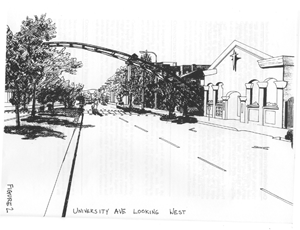
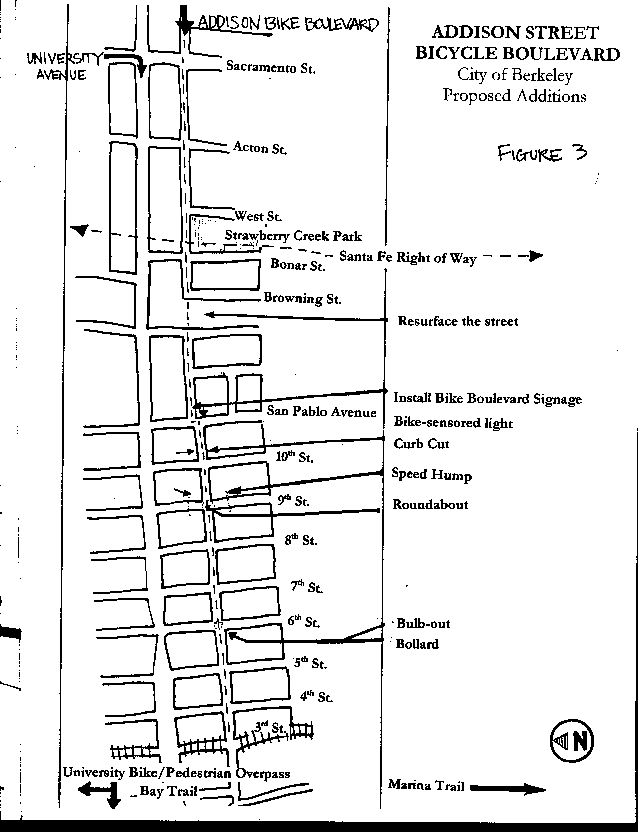
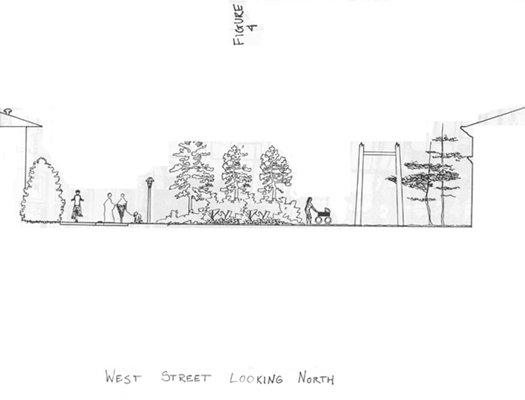
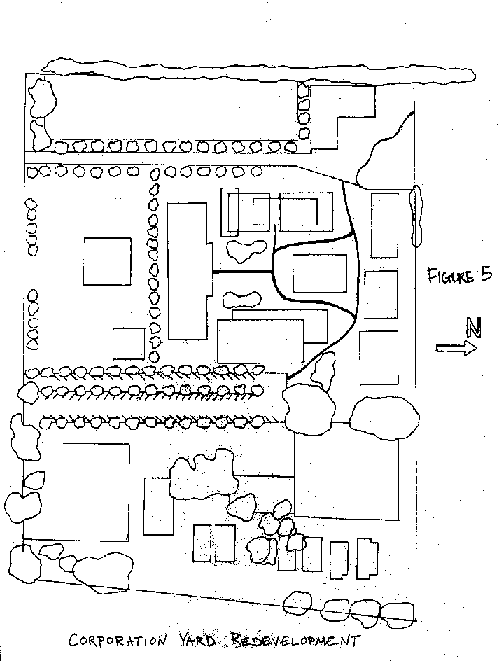
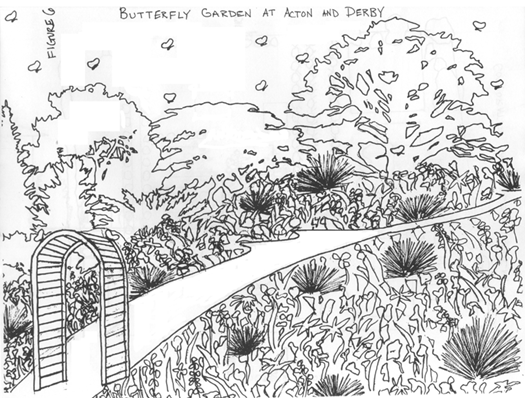
“Improving and Restoring Native Habitats and Landscapes of Berkeley”
GROUP MEMBERS:
Joydip Basu
Saana Deichsel
Harland Patajo
Guadalupe Bumatay
Berkeley is one of the more ecologically conscious cities in
the U.S. Residents treasure their parks and open space. Those who promote the
green spaces in the city are very active in doing so. Though, the size of these
undeveloped lands is limited by the lack of contiguous open space in the area.
The Right-of-Way is an exception to this, and in determining what the best use
for it is, we had to take this into consideration. The suggestion of
constructing houses or stores on the plots came up, but we felt that there were
more appropriate places in Berkeley for that. There are currently empty lots and
vacant buildings throughout the city that are more deserving of developers’
attention. The areas where these lots are (especially South and West Berkeley)
could use the economic stimulus that such projects would bring.
Our group felt that it would be a waste to pave over more areas in Berkeley. The environmental impacts of overly paved cities are extensive. After big storms, the water from our roads has nowhere to go, and just runs off the pavement, along with the oil from cars. This ends up in our creeks, and eventually the Bay. This fact in itself represents a good defense for avoiding more covering of unpaved places. We decided to take the environmentally aware approach to our plan: ecological restoration.
However, we didn’t want to just restore areas that were currently unused, but mend what we felt was poorly maintained land along the stretch. Sometimes when restoration projects take place in an urban area, there will be a lot of work put into them, but not keeping up their maintenance. We feel this has happened in Strawberry Creek Park, where the creek was daylighted several years ago. The creek bed has fallen to disarray and the park underutilized.
As a society, we are becoming more and more conscious of the problems associated with bringing non-native plants into a landscape. Some plants take over the natives and this leads to a loss in biodiversity and the threat of extinction for some species. There are many unique plants native to the Bay Area and California, not found in their natural setting anywhere else. In our design, we promote a native species theme for the Right-of-Way, as an educational tool, for aesthetic purposes, for ease in care and maintenance, appropriate for the Mediterranean climate, and to promote biodiversity.
The northern section of the Santa Fe Right-of-Way has the potential to connect existing greenways and link park networks together. Just north of University Avenue the Santa Fe Right-of-Way is used for makeshift parking lots and walkways that are unfenced until I block before Cedar Street. The installation of a bike/pedestrian pathway that is continuous from Strawberry Creek Park to Cedar Rose Park will link green networks from central Berkeley to north Berkeley. The use of native vegetation along the pathway will make a bike ride or walk a pleasant and educational experience. Finally, in keeping the theme of ecological restoration the daylighting of Schoolhouse creek, which intersects the right-of-way at Lincoln Street would add to the experience of the greenway and its natural habitat. Please refer to Figure 7 for the Northern Portion Creek Restoration section.
Currently, there are
plans to build a greenway from University Avenue to Delaware Street
accommodating for the potential use of a walkway for the Berkeley Montessori
School. Connecting this greenway to Cedar Rose Park is the next link that will
make a broader statement of greenways and parks throughout Berkeley. A 6-foot
wide bike/pedestrian path that connects to the Ohlone Greenway creates better
access to Strawberry Creek Park and will allow users to travel easily from north
and south of University Avenue to enjoy the network of parks and ecological
habitat.
Native Plants
The use of native California plants along the pathway is already being implemented along a portion of the Ohlone Greenway for cultural and native history on Peralta Avenue. The ecological restoration group encourages the use of native plants along the greenway in order to restore some of California’s natural habitat. Because native plants will be acclimated to Bay Area weather, maintenance and upkeep of the greenway’s habitat will be minimal compared to foreign species that require large amounts of water or are invasive to the area. A mixture of coastal prairie and coastal scrub will provide low-lying shrubs and grasses to compliment the experience of the greenway. Berkeley sedge, California fuschia, Lupine, and the California Poppy are coastal prairie plants that will provide low-lying, flowering vegetation along the greenway. Larger coastal scrubs like Alameda Manzanita and Monkeyflower are larger shrubs that are a prime example of native plants. Trees such as the California Bay and Monterey Cypress, which can already be found along sections of the Right-of-Way, will provide some shade for travelers and will add to the diversity of the vegetation along the Right-of-Way.
The Schoolhouse Creek restoration will begin at end of the Virginia Gardens block, where current Basketball courts and volleyball courts lie and returned to a culvert at the beginning of Lincoln Street. An 18-foot wood bridge will be installed where the creek intersects with the planned greenway allowing users to enjoy a restored natural habitat of the area. In our site analysis of Strawberry Creek, we found that concrete stabilization banks (riprap) used provided unnatural material taking away from the integrity of the creek, which eventually caused erosion. Therefore, the use of log cribwalls will be installed for bank stabilization in order to promote vegetation along the banks while at the same time providing an ecological and durable stabilizing material. The use of Alders, Willows, and Tan Oaks will also help to strengthen the banks and provide natural habitat for riparian zones. Sword fern and Elderberry will provide ground vegetation and understory for the trees. The daylighting of Schoolhouse Creek will continue a movement of creek restoration projects nationwide while at the same time re-introducing the neighborhood to a restored ecological habitat that has been buried for many years.
In terms of renovations and improvements along the central section of the Right-of-Way, the ecological restoration group decided to concentrate its efforts on changing parts of the Corporation Yard and the southern portion of Strawberry Creek Park. We decided to include a full-sized soccer field and a Zen/Botanical Garden that would require the removal of a few buildings within the Corporation Yard and existing cement courts in Strawberry Creek Park. We’ve found that these two additions would best serve the surrounding community in response to analysis done through surveying mapping in the earlier phase of our project. In addition to changes, we decided certain areas should be kept the same since they flowed with the rest of the design and did not have to be removed. Sections like the basketball courts on the eastern courts were kept since they were heavily used. Another issue that was brought up was whether the area should be for just one particular use like relaxation or strictly athletic uses. Rather than concentrating on making the area just something for sports or relaxation the group decided to accommodate multiple users. Please refer to Figure 8 for a detail of the Central portion section.
By including a garden and sports field, both sides are attended to. It was our hope to create and area for both older and younger users.
SOCCER FIELDThe implementation of a soccer field is a great renovation for the city because it can be used for multiple purposes. Besides being a place where league games and practices could be held, it has potential to be a place for the community to gather, do small-scale concerts, shows, parades, and other events. The facility is equipped with bleachers so areas for sitting and watching would be available for all of these events
In terms of lot space and size, it was a perfect fit for the
area. There are not many places that could fit a soccer field that runs 100
yards in length. In this particular section of the Right-of-Way, the
Right-of-Way land would be occupied completely by the field plus 50 yards into
the Corporation Yard. Other suggestions from the community for potential uses of
this space included the idea of the dog-park, because many residents are looking
for a recreational area to walk their dogs. However, since there are many
residents living in the area, and noise would be a large issue, it was decided
that this option would not be the best course of action.
The geographic location of Strawberry Creek Park and the Corporation Yard are ideal for uses that serve the community and the entire city. The location lies in the heart of the city, which is centrally accessible. Second, by being positioned in the Right-of-Way, it has multiple access points to serve a greater portion of the community. In addition, soccer-related activities something that youth of the area are almost begging for, and so in addition to physical logistics, including it in a location receptive to community activity supports its creation.
Another segment of design the ecological restoration group
decided to incorporate is a Zen/botanical garden element along the northern
portion of Strawberry Creek Park. The elderly community would benefit immensely
from such an addition. In fact, as part of the analysis, it was concluded that
the older people in the area wanted some type of area to relax and meditate in.
A Zen/botanical garden provides an area where this goal can be accomplished.
A native landscaping theme was one goal the group wanted to incorporate since native plants are very sustainable to the environment. They are simple to maintain and easy to plant and produce as opposed to using exotic plants that take more watering and care. Native vegetation and trees would be incorporated in the design of the Zen garden. To avoid incurring heavy costs due to maintenance and planting, the local community could be asked to get involved and help. By giving them a greater role, it will make them a more vital part to the community as well as make them take ownership of things that may go right and may go wrong.
Some elements that are included in the Zen garden are a pond, gazebo, bathroom, and store room. The idea was to make something not too complicated and easy to maintain. These elements are relatively easy to clean yet offer a peaceful release from daily stress. The tranquility provided by the pond and natural landscape provides something that cannot be experienced elsewhere in Berkeley. We incorporated native plants and trees within the garden, to go a long with the rest of designs on the northern and section portions of the Right-of-Way. Since one theme we concentrated on was using native plants, we felt that they should be incorporated in the Zen Garden rather than exotic plants. Another theme we used heavily when thinking about what to include in the proposal was ecological restoration. To restore the area, using native plants would be sustainable and ecologically safe. We designed with both these themes in mind.
SOUTHERN SECTION
For three adjacent blocks on the southern portion of the
Right-of-Way, between Ward and Parker streets, we will expand on the ‘native
plants’ concept and actually recreate California landscapes. There will be a
path running through the blocks, with benches placed about. For educational
purposes, there will be markers by the plants telling those who are strolling
through the area what the species is, where it is found geographically and an
interesting fact about it.
Between Ward and Derby streets will be the Redwood grove. Since they are such a beloved and unique part of the California landscape, and as there are so few groves of them left (especially in the East Bay where they used to be common), it seems like something the community in this area could get joy from.
The Redwood forest will be modeled after the typical grove in the Mendocino area. In the dominant overstory would be Redwood and Douglas Fir. In the understory would be tan oak; California bay, madrone, Wax Myrtle. The shrub and grass understory would consist of Pacific rhododendron, sword fern, and a groundcover of Redwood sorrel. This area would require more effort to get started and maintain in the beginning. Redwoods need moisture in the form of fog, and this particular area of Berkeley doesn’t get so much.
Between Derby and Carlton streets will be an Oak Woodland landscape. Coast Live Oaks are the dominant overstory. With these we would like California Back Oaks, and Blue Oaks. Manzanitas have such beautiful bark and add lovely red color to the scheme (and are drought tolerant Arctostaphylos franciscana is a manzanita native to San Francisco that is almost extinct, and will be included in the understory. This will also consist of Huckleberry Oak.
Oaks are a vanishing element of the California, scene. It is important to educate people about the history, present and future of Oaks in the state Currently, Sudden Oak Death (SOD) is a tremendous threat to the shape of the landscape. The plot will include informational plaques telling how SOD impacts Oaks and other species, how it is spread, and how it can be stopped.
Between Carleton and Parker will be a 'field' of wildflowers. In our research we learned that the Cal colors of blue and gold were decided upon because of the great abundance of Golden Poppies and Blue Lupines in the vicinity. Other California wildflowers will be scattered throughout such as Wild Lilac, Baby Blue Eyes, Dandelions, Douglas Iris, Violet and Miners Lettuce. The plot will be arranged so that there are knolls (to help with draining of water) with trails running around them so that people can walk through the patches of flower. This block will require more work to keep up than the others will, we predict.
On the two blocks north of this (between Parker and Dwight) we propose a children’s park. The northern most section will be for a tot-lot for younger children and the southern section will have a playground for older children. Because residents had expressed great interest in a park with barbecue pits and picnic tables, these will be arranged in a nice woody area of the park. Please refer to Figure 9 for a detail of the Southern Section Redwood forest detail.
Ecological restoration combined with multiple recreational activities on the Right-of-Way will serve a diverse amount of community members while at the same time preserving valuable open space in the city. Our approach to ecological restoration along the Santa Re Right-of-Way was to make this space an ecological experience using California native plants while at the same time providing different uses for multiple user groups. Our plan emphasizes the connection and improvement of existing park networks that will broaden the links of open space in Berkeley. The cost and maintenance of building a greenway and using native plants will be relatively, inexpensive compared to placing development along the Right-of-Way. In the long run, the transportation, educational, ecological and long-term environmental benefits to keeping the Santa Fe Right-of-Way green will outweigh the costs of implementing ecological restorations today.
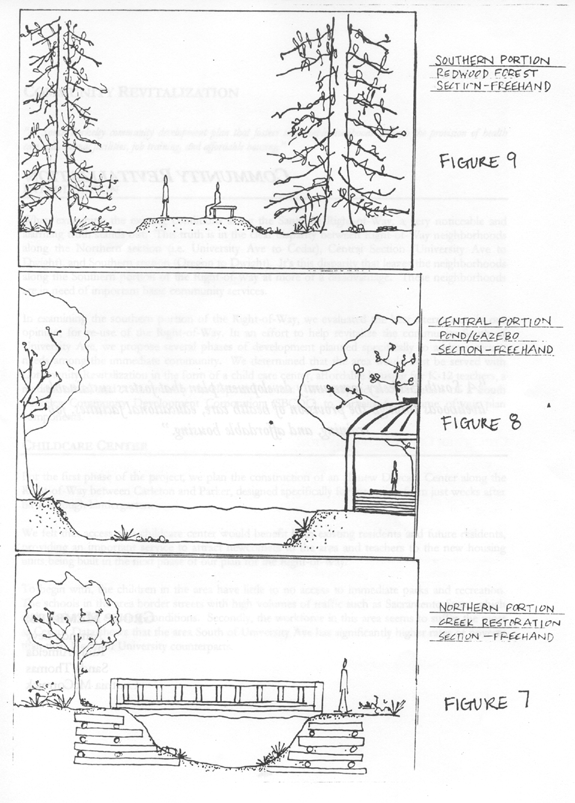
“A South Berkeley
community development p/an that fosters
sustainable livelihoods through the provision of health care, educational
facilities job training, and affordable housing."
GROUP
MEMBERS:
Amanda Levy
Rudy Almeida
Sandy Thomas
Cynthia
McCormick
When examining the existing conditions along the Santa Fe Right-of-Way, a very noticeable and alarming truth stands out. This truth is in the clear disparity between Right-of-Way neighborhoods along the Northern section (i.e. University Ave to Cedar), Central Section (University Ave to Dwight), and Southern section (Oregon to Dwight). It’s this disparity that leaves the neighborhoods along the Southern portion of the Right-of-Way at more of a disadvantage. These neighborhoods are in need of important basic community services.
In examining the southern portion of the Right-of-Way, we evaluated the best alternatives, in our opinion, for re-use of the Right-of-Way. In an effort to help revitalize the community South of University Aye, we propose several phases of development planned specifically to address certain needs among the immediate community. We determined that the area would best be served with Community Revitalization in the form of a child care center, affordable housing for K-12 teachers, a medical clinic, and a community development center. We propose the formation of a South Berkeley Community Development Corporation SBCDC to partially fund some of our plan components.
For the first phase of the project, we plan the construction of an all new Daycare Center along the Right-of-Way between Carleton and Parker, designed specifically for tots aging from just weeks after birth through kindergarten.
We felt that access to a childcare center would benefit both existing residents and future residents, providing an important service to attract newcomers to the area and teachers to the new housing units being built in the next phase of our plan for the Right-of-Way.
To begin with, the children in the area have little to no access to immediate parks and recreation. The schools in the area border streets with high volumes of traffic such as Sacramento Street which make for unsafe crossing conditions. Secondly, the workforce in this area seems to suffer the most as Census Data shows that the area South of University Ave has significantly higher rates of poverty than their North of University counterparts.
Through this project, we hope to make an immediate
impact in the community by enabling TANF (Temporary Assistance for Needy
Families) recipients and low-income parents to participate in the workforce by
affording child care services.
The main goals of the Santa Fe Right-of-Way childcare
project are as follows:
·
Expand the availability of full day child care in South Berkeley in order
to support participation in employment, training, and educational activities by
low-income parents.
·
Support and increase the quality of childcare in Berkeley.
·
Support the growth and development of children ranging from infant to
kindergarten.
·
Prevent Child abuse and neglect.
· Promote health and safety.
We hope to provide quality affordable childcare to local residents along Right-of-Way neighborhoods. The daycare center would follow NAEYC (National Association for the Education of Young Children) standards for child to daycare giver ratios of one caregiver for every three babies if there are six infants in a group, and one for every four if there are eight babies in a group. NAEYC requires that eight babies should be the maximum number in any group.
For the project, we will
seek to utilize 100% of federal and state funds allocated to provide child care
services and we will strive to maximize the use of already available funds for
child care services through local partnerships.
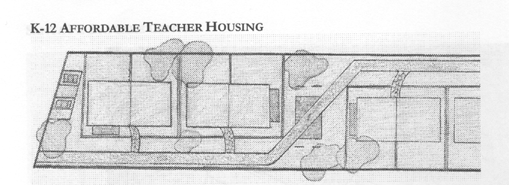
The second phase of our plan will be the construction of 16
units of affordable housing located along two blocks of the Right-of-Way between
Ward and Carleton. The new housing would serve K through 12 teachers.
Currently, the city of Berkeley is faced with a housing shortage. However, the City of Berkeley is hesitant to develop on vacant land because the city believes that open spaces should be reserved for parks and recreation. In order to meet the housing demands of the growing population of Berkeley and to incorporate public spaces and parks into the city, our housing development on the Right-of-Way mixes both affordable housing and public open spaces. Each of the housing complexes is lined by a mixed-use walking path that travels through a park in the center of the Right-of-Way and then the path continues to the end of the block.
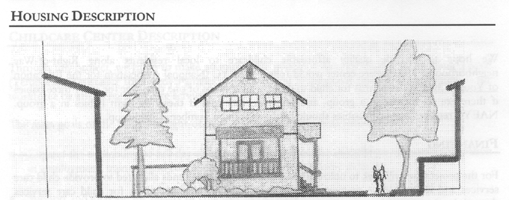
On each block of the Right-of-Way, there will be four
duplexes or eight units of housing reserved specifically for K through 12
teachers. On the two blocks where we are developing housing, there will be a
total of 16 units of affordable housing built. The duplexes will be side-to-side
and each will have their own proportionately sized backyard. Each of the units
will be approximately 1,250 square feet and will be two stories in height. In
addition, each unit will have one parking space on the Right-of-Way. Each of the
units will also have a balcony.
In the middle of the Right-of-Way there will be a community
park with benches surrounding a flower garden or a garden full of native
vegetation. Residents of the area will be able to access the park by walking
paths that traverse through the blocks. The walking paths will also connect the
housing to both the medical clinic and the day care center. The parks will be
safe from crime because the two surrounding duplexes on each side of the park
will have balconies and windows facing the open area. The “eyes on the
street,” will deter loitering and illegal activity.
A majority of the funding may come from either the South Berkeley Community Development Corporation (SBCDC) or the City of Berkeley. Each of the units will be rental only and will be kept at affordable housing rates. The housing will be reserved specifically for teachers in the area. The incoming cash flow from the rents can be used for developing and maintaining the community development center, medical clinic and the day care center. Furthermore, each of the residents of the units will pay a monthly fee for the upkeep of the Community Park.

The third and final phase of our Community Revitalization Plan will be a Community Development Center and Medical Clinic. The Community Center will be located at Sacramento, just south of Oregon along the Right-of-Way. The community center is an instrumental part of our plan and will serve the needs of the surrounding community. Low-income residents who are unemployed and/or do not have access to a computer will especially benefit from the Community Center.
COMMUNITY
DEVELOPMENT CENTER DESCRIPTION
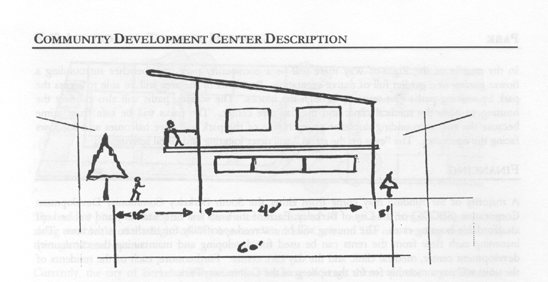
The physical description of the Community Development Center is as
follows. The proposed Community Center will occupy a section of the Right-of-Way
that is 60’ wide by 250’ long. This can best be seen looking north from the
corner of Oregon at Sacramento and ends at the cul de sac end of Sojourner Truth
Court.
The lot will be utilized in 4 main ways: 1) the main building foot pad, 2)
two half court basketball courts with a grassy play/lunch area, 3) parking for
16 tandem style parking spots off Oregon and 4) a throughway for the pedestrian
walkway that connects all our projects on the south end of the Right-of-Way.
The building will sit on a pad of approximately 120 ft. by 40 ft. This is
a two-story building pushed back to the east-side of the lot, save for a 5’
wide access way along its back. This creates a building with 4,800 sq ft. of
office/training space. The building will be almost centered in the length of the
Right-of-Way and balanced by the basketball courts and parking on either side.
Open access for the walkway runs along the west-side (at the front doors) of the
building. The walkway area is approximately 15’ wide, give or take any small
scale landscaping efforts. It is important that the property maintain this
walkway as part of the public domain and that it is not given over to a
privatized sense of use for the Community Center alone.
We
envision the layout of the building in such a way that the ground floor will be
used for job training, counseling and placement. Primarily, job training will
focus around updating computer learning skills, resume development, assistance
with job applications and some sort of financial assistance center or money
management classes. The second floor will house the South Berkeley Community
Development Corporation’s SBCDC office operations and staff. The building
should be large enough to house a staff of 20 people comfortably on each floor.
We would like the building to be designed in such a way that it would incorporate the latest technologies in sustainable, “green” building design. We encourage the use of recycled or at least sustainable building materials and principles throughout the project. Solar panels, double-pane windows, wall, roof, window and door treatments that enhance winter and summer insulation. Alternative electrical energy sources would be sought to give this building a “green” stamp of approval.
Ideally, landscaping on this block would coordinate with the medical clinic on the adjacent block across the street. In this way the thematic concepts of the Community Center, along with the walkway will be held open for public view and access onto these common grounds. It would be great if the Community Center became a landmark or destination place for the surrounding neighbors.
In addition to a computer/media center, job training and placement, and a career library, the Community Center will provide school age children with an after-school program. The after school program will meet the interest of the students as well as the needs of their parents who may not otherwise be able to provide supervision between the hours after school and evening. A basketball court located on the grounds of the Community Center will provide a desirable form of recreation for the students and provide a means for the students to interact with other teenagers in the community whom they may not otherwise come in contact.
MEDICAL CLINIC DESCRIPTION
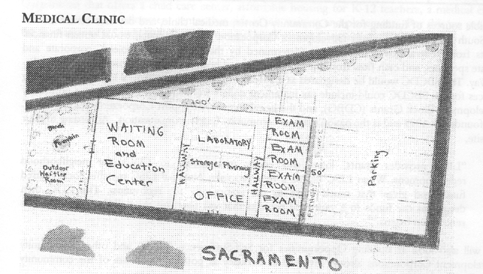
A medical clinic, adjacent to the Community Center, north of Oregon on the Right-of-Way, will provide free and low-cost medical services to the surrounding community. Many people in South Berkeley do not have access to affordable health care. Many residents are uninsured and given the current economic situation, the number of uninsured will likely continue to rise. Statistics show that when compared to other parts of Berkeley, South Berkeley residents live eleven years less and South Berkeley infants are of a lower birth weight.1 During our neighborhood survey analysis, many residents stated that they do not have access to basic services, such as health care. A South Berkeley neighborhood medical clinic would serve the needs of this community by providing primary family medical and preventative care; prenatal care; individual, group, and family counseling services; and health and dietary education.
The medical clinic will be a one-story structure that is 50 feet wide by 100 feet long, for a total of 5000 square feet. The clinic will have four examination rooms; a front office; a pharmacy; a laboratory; a storage room; a waiting room/education center; and an outdoor waiting area with fountain, benches, and pleasant landscaping. There will be an adjacent parking area accessible from Sacramento Street as well as Oregon Street. The parking lot can be used for the medical clinic and for extra parking for the community center. A pedestrian crosswalk with signage will connect the medical clinic and the community center. Curb bulbs-outs can be used in this area as a traffic calming device.
FUNDING
Possible sources of funding for the Community Center, medical clinic, and day care center include the South Berkeley Community Development Corporation (SBCDC) which would obtain financial grants from federal government funds (determined by the scale of the project), corporate and private sponsors, and cash flow from the city owned rental housing we’ve proposed along the Right-of-Way. The SBCDC would be designated as a 501c3 corporation under federal law. Other funding sources for the SBCDC could include tax increment dollars from the City of Berkeley, Community Development Block Grants (CDBG), and the Local Initiatives Support Corporation (LISC). LISC was founded in 1979 and is the nation’s largest community building organization. According to their website,
“LISC provides grants, loans and equity investments to CDCs for neighborhood redevelopment. When LISC begins a new program, National LISC matches locally-raised funds and gives that much more to the community for renovation. The CDC then designates the funds to a variety of projects that will best suit the neighborhood, and the renovation begins.”2
We will also look at Building Opportunities for Self-Sufficiency (BOSS) and other Community Development Corporations already involved in Berkeley as potential sponsors of the community revitalization project.
CONCLUSION
The developments we propose for the Right-of-Way may seem counterintuitive to laudable requests for green space. By designing in new buildings on the ROW it looks as though we are calling for geater density in an already dense urban environment. But, it is clear that Berkeley is in desperate need of affordable housing for all types of households.
Our presentation for re-use of the Right-of-Way addresses general issues of equity with quantifiable, attainable goals. The disparity between the northern and southern sections of the Right-of-Way can be seen in our citizen surveys of the area. Information we gathered in our surveys points out that southern neighbors would rather pay more taxes for greater social benefits, are open to affordable housing in their neighborhood, are involved more so in community organizations and are more likely to own their own homes. On the other hand, this population has farther commutes to work and school, have a greater number of people living in their households and of those have a greater number of children, many of which are female headed households and in an age bracket that is older than the northern section.
We maintain that the south side of the Right-of-Way is in need of basic community services that serve this particular population’s needs more effectively.
We propose planned phases of development that specifically address the needs of the immediate community. We offer that the services come in the form of a Community Development Corporation that offers a child care center, affordable housing for K-12 teachers, a medical clinic, and a community development center that aids in job training and placement. For this we propose the formation of a South Berkeley Community Development Corporation (SBCDC).
Although all four concepts presented in this final report for the Right-of-Way have differing agendas, there are themes and issues about the Right-of-Way that our class has come to consensus on.
Themes that stand out across all developed views on the Right-of-Way are the following:
· Piecemeal sell-off of portions of the Right of Way has fragmented what could have once offered more complete and creative choices for reuse of the RIGHT-OF-WAY
· Collectively our research has shown that cosmetic and infrastructural improvements need to be made to Strawberry Creek Park.
· Well-developed plans for the crossing of University Avenue should be brought to the forefront. The intention behind this idea is to create and maintain physical and psychological connections between the north and south sides of the Right-of-Way, as well as solve a problematic crossing for children and adults across a busy boulevard. Also, this is one way to promote the Right-of-Way via a highly visible structural device such as an overhead pedestrian walkway.
· There is a definite voice from the people for green space, in some form, on Right-of-Way.
· Connections, identified as pathways that connect to others bicycle/pedestrian paths that lead to other economic and cultural groups within the City as well as public access to the waterfront.
· The notion that the Right-of-Way was once something, that it has historic value and personal meaning, that it can be attached to the emotional character of the City and its residents is of great value and an element that could be brought into any future designs along the Right-of-Way.
· A common theme through all our presentations seemed to include active play/educational space in varying degrees that is targeted at kids and toddlers living in Berkeley. We felt it necessary to create parks and play structures, day care centers, skate parks, active gardens, soccer fields, basketball courts and bike paths. These were general developments that seemed to be in tune with a cross section of residents along the Right-of-Way.
· Financial planning for the Right-of-Way, at least in the area of operation and maintenance, should not be borne by the City alone. Our citizen surveys conveyed a surprising willingness on the part of residents and park users to help pay for parts or aspects of Right-of-Way accoutrements. Local users could be given the opportunity to memorialize a loved one with a bench plaque or plant a tree or be part of a house raising on the Right-of-Way.
· These personal efforts and contributions on behalf of citizens are bridge builders to having residents identify and defend this public space as their own. It is important that resident see this space as a place worth keeping and worth maintaining. It is this aspect of the public realm that creates opportunity for public interaction, simple conversations and people watching.